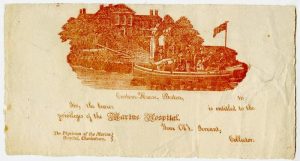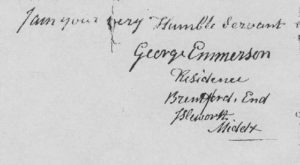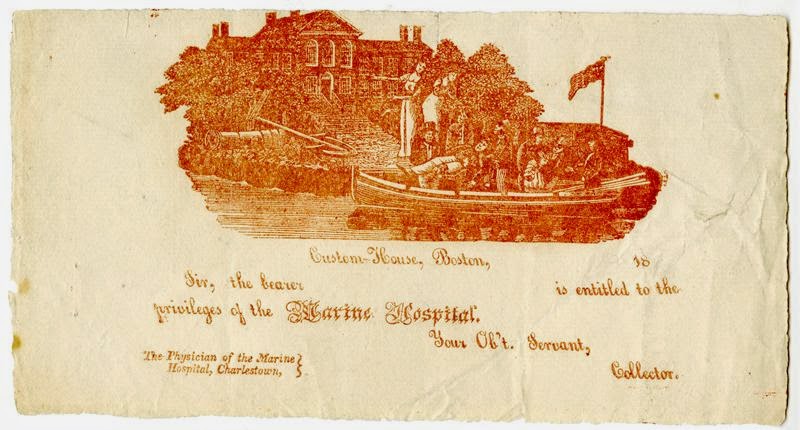In the past, this blog has brought you personal stories of American sailors- their small triumphs and tragic endings, their daily struggles and memorable reminiscences. Now we bring you the life of a British seaman whose career ended badly on August 19, 1812.
In about 1823, one George Emmerson applied to the British government for a pension. He’d been wounded in the service of King and country, and like so many injured seamen in the wake of the long Napoleonic Wars, had to support himself as well as he could.
His application consisted of a “memorial” written in his own had. The following transcription preserves his somewhat erratic punctuation and charming phonetic spellings:
Memorial of George Emmerson able seaman and Sailmaker – in His Majestys Service from June 1803 to January 11th 1813
I Entered into His Majesty Service at North Shields in June 1803 – I had then been about four years in the coal trade – from London to Shields in a brig belonging [to] London. On my arrival at the Nore I was drafted on board the Colossus 74 then a new ship on her first going to sea. July 7th 1803 – Captain Martin Commander, – who afterwards was succeeded [by] Captain J. N. Morris in 1804 who also commanded the Colosus in the Battle of Trafalgar. Our Captn was wounded in the knee – I was in the Battle of Trafalgar in the Colossus – for which Battle I have a medal – our ship took the Bohemy and the Swiftshour1, they both struck to our ship – after an Engagement of about five hours – our killed and wounded was about 2002 – our ship was then sent home to Portsmouth, – I then joined the Canada 74 – Decr 12th 1805, Capt John Harvey Commander we sailed to Barbados, from there we joined the Squadron on that station, – We sail’d after the French Squadron and chased them but lost them in the night of[f] the Island of Toutoler3 – the Cannada was sent home and laid up at Chatham in January 1808, – at Chatham I passed the yard as a master sailmaker, and have my certificate from Chatham Dock yard (and I received my warrant after at Halifax, signed by Sir John B. Worren. – I was appointed to the Guerrier 38 Capt Alexr Skene commander – I joined the Guerriere the 4th day of January 1808. – We sailed to Jamaca – had the duke of Manchester on board, the governor of Jamaca. – from Jamaco we came on the Halifax Station, and sir J. Peachel joined our Ship [as] our commander, – afterwards Captain J. Richd Dacres who was our commander in the action, with the Ammerican ship Constitution 50 Guns – the Guerriere being dismasted and in a sinking state, surrendered – to the Enemy – in the action I was badly wounded I received a musket shot in my left legg in a downward direction the shot passed down my legg from the calfe to the instep and ledge there and the shot broke the bone of my legg in a shatterd manner. – I suffered much from pain, being prisoner and moved about so often from ship to ship, and was put on a currintine Island4, then move to Charlstown Hospital in the States- there I got my legg set after 14 days, – in about fourteen days more, I was exchanged and sent by the Carteel Ship to Halifax Nova Scotia, from that Hospital I was sent home by the Africa to Plymouth or Haisburouh Hospital, – Octr 1812, – at the Hospital I was discharged uncured January 11th 1813 – I Received a ticket from Grinwich Hospital for four pounds per annom – which I now still receve yearly – I was 10 years in the service – but being ignorant of the numbers of years Servitude required for a pension prevented me from applying for a pension for servitude 10 years, –

It must have seemed as if he lived a charmed life. He survived the Battle of Trafalgar without a scratch, and three years later he had received a sailmaker’s warrant, insuring him a steady billet and a steady income.
And then he got posted to the Guerriere. We know how that ended. Besides being a tragedy for the Royal Navy, it was a personal one for George Emmerson. And yet, his later life had its share of joy.
He married a woman named Elizabeth and they had five children before she died of a “bowel Complaint” in 1826. The following year George married another woman named Elizabeth who bore him five more children (two of them died in infancy).6
George had established himself as a sailmaker in Isleworth by the 1840s, but in April 1846 all his hard work went up in smoke.
Fire at Isleworth.—Shortly before ten o’clock on the eve of Good Friday, a fire broke out in Northumberland-wharf, Brentford-end, Isleworth, upon the premises in the occupation of Mr. George Emmerson, sail maker. Engines attended from New and Old Brentford, two private, and others from Richmond, Ealing, Chiswick, and the brigade stations in the west of the metropolis. The fire was not subdued until a shed, used for warming oil and tar for tarpaulins, and the counting-house over it, were burned down. The contents of a sail loft, 36 feet by 30, were seriously damaged, the roof burned off, and the stock in the adjoining granary, 45 feet by 24, belonging to Messrs. Keene and Blake, lightermen, considerably damaged by fire and water. It is not known how the fire originated, Mr. Emmerson is insured for the contents in the Globe-office; building, in the Phoenix. Messrs. Keene and Blake are insured for the contents and building in the Globe Fire-office.7
After that, the record goes silent. By this time, George was nearing 60 years old, and it is likely he declined in health and stamina. We’ve not yet determined when he died, but he must have told some amazing stories to his family before he went.

We are indebted to Mr. Mark Ellis and Ms. Sarah Emmerson for sharing George Emmerson’s memorial with us.
1 That is, the Bahama (74) and the Swiftsure (74).
2 The Colossus suffered the highest casualty rate of all the British fleet- nearly 35%.
3 Tortola.
4 Rainsford Island, in Boston Harbor.
5 Frederick Arthur Crisp, Fragmenta Genealogica, Vol 7, (London, 1902), 17.
6 Ibid., 17-19.
7 London Daily News, 11 April 1846
The Author(s)
Matthew Brenckle
Research Historian, USS Constitution Museum
Matthew Brenckle was the Research Historian at the USS Constitution Museum from 2006 to 2016.
